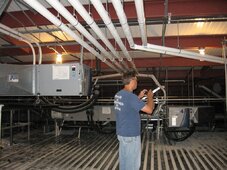I have so much excess HVAC capacity (despite being less than half the office building guidelines) that it would be reasonable to install a control system to peak shift thermostat demands. Basically, avoid a random event where too many are on at once.And those peaks are due to multiple AC units turning on at once so a few ESP devices set up to make sure that cannot happen via the thermostats would mitigate that.
The top end idea is to monitor my total building demand from the grid and set a threshold that prevents more HVAC units from operating until we are under that threshold. Basically use the HVAC units as load shed. I would need some timeout on this to keep from starving the building for HVAC if we have other demands, but it would trim my peaks and save demand charges.
This sort of system is a bit of development, but relatively low cost.
Shaving my peaks helps in all possible systems, no solar (reduces demand charges), only panels (lowers times of grid import), and with battery storage (keeps inverter and battery load down). So this is an idea that works for all possible futures.
My parents in Sarasota, FL on FPL definitely want power backup. They suffer multiple days of outages with hurricanes. They cannot move or evacuate during these events. They are also driven mad by nuisance outages from FPL, brief outages that are just enough to drop every clock and computer. My mother has at least a dozen UPS all over the house and keeping them happy is a pain (the batteries age out all the time). So they are very interested in some sort of backup system that can power the house for at least a day or two on a critical panel. If we add solar panels to that, then they get economic benefits as well as extended off grid run time. They can still get 100% net metering, so they can easily reach economic viability.Battery backup is very nice in a hurricane area and not relying on FPL is cool even though their rates are very reasonable.
These issues do not afflict my building, however. That would be purely an economic play, and without 100% net metering, the payback period is lengthy.
My minimum monthly meter charge is $15 which has me considering what it would look like if I went "off grid". What I mean by that is try to meet my energy needs entirely through solar, but keep the grid as the backup "generator". If I have a string of cloudy days, draw from the grid. This would require a hefty battery bank, like 500 KWH or so, to approach off grid reliability. That's $100K in batteries alone.
I have not yet factored in the tax credit to all this, so that helps. A business gets 30% for the system total cost, another 10% if you meet a domestic content threshold, and another 10% if you build at certain sites. I get the first, maybe the second (depends on equipment choices and costs), and won't get the third, so 30% for sure, maybe 40% if I can find enough domestic sourced materials to reach the threshold.
Mike C.
Last edited:




